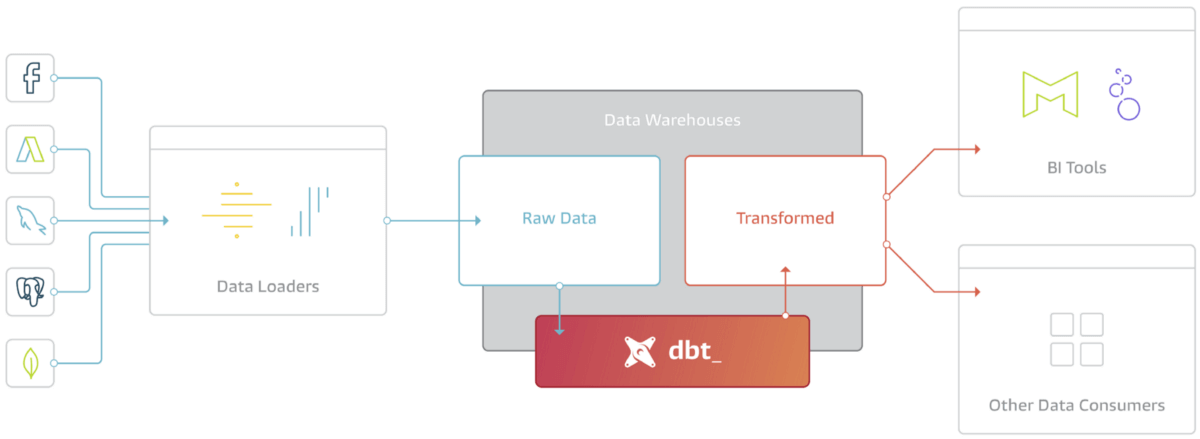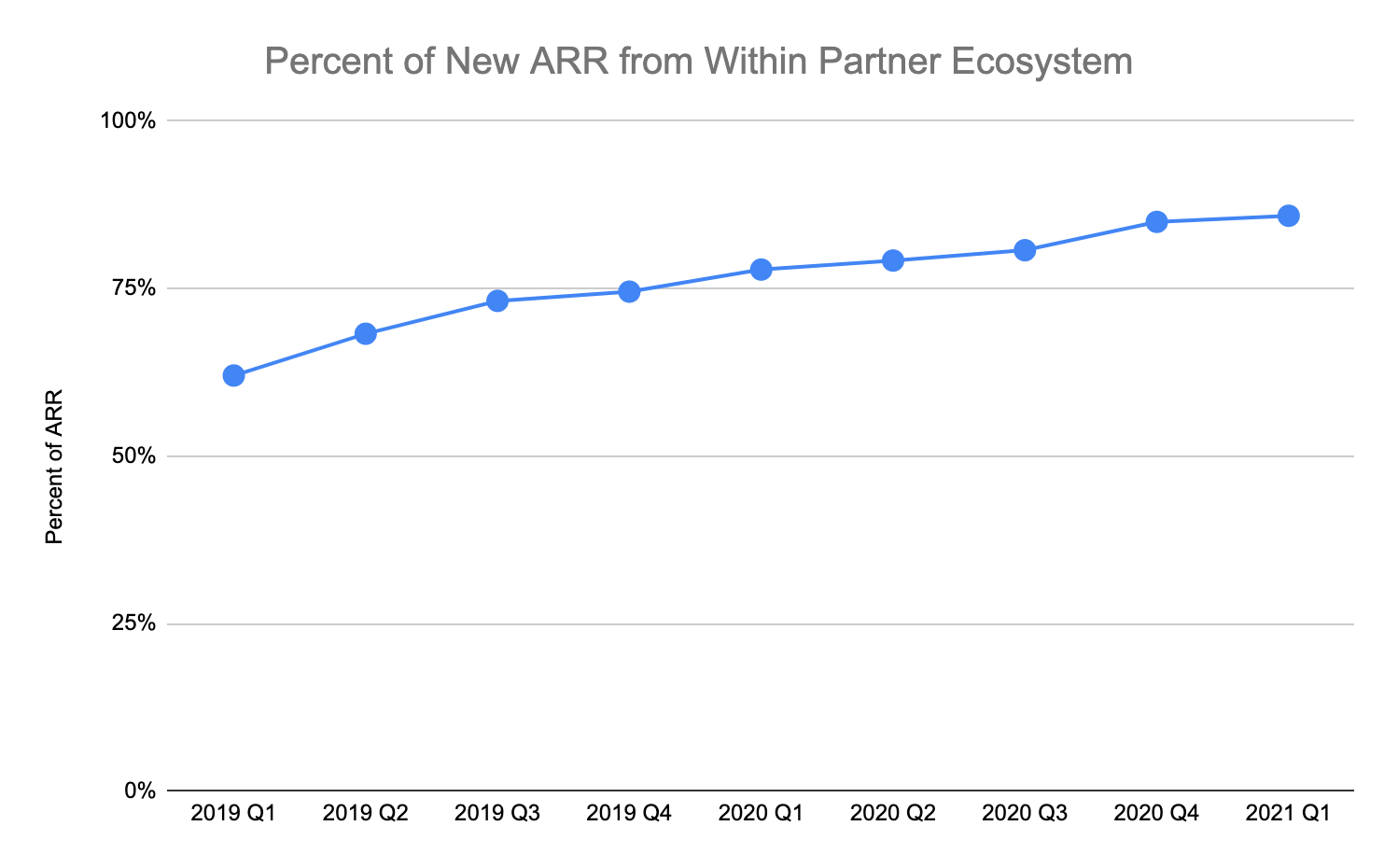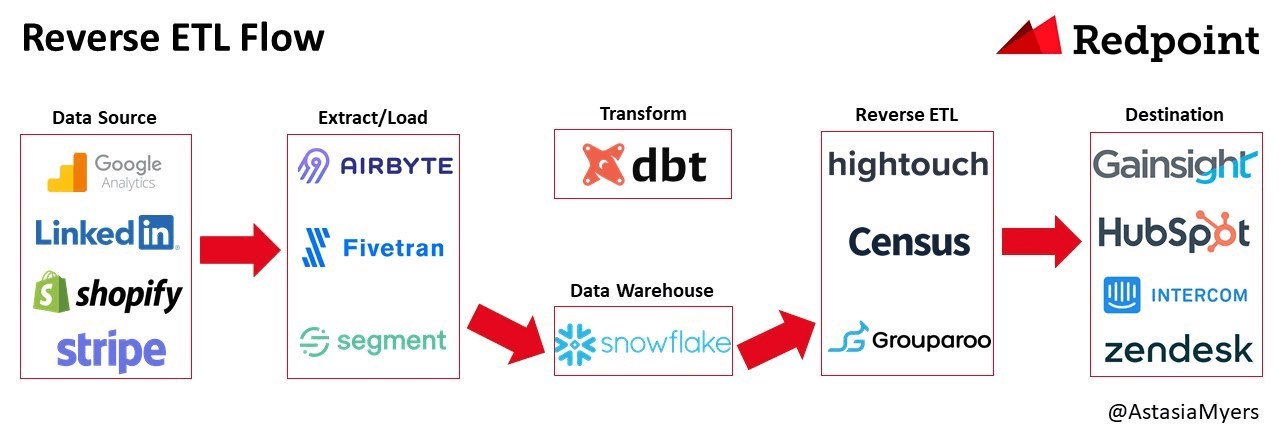Today, I’m the CEO of Crossbeam. But I spent the first eight years of my SaaS career in the murky depths of the analytics market, and let me tell you: Data warehouses changed everything.
If you work at a modern company, chances are that a cloud-based “data warehouse” is powering a lot more than you realize. In simple terms, your company’s data warehouse is a big, centralized data store where you can combine data from many different sources.
Popular cloud data warehouses include Snowflake, Amazon Redshift, and Google BigQuery. Offerings also exist from Microsoft, SAP, and countless others. Cloud data warehouses have become so prevalent in modern tech infrastructure that everyone should have a working knowledge of what they are and how they work — including partnership professionals.
Intro to Data Warehouses
The Modern Data Stack
What many people don’t realize is that data warehouses are actually required in order to use business intelligence (BI), visualization, and dashboarding tools.
If your company uses a BI platform like Looker, Tableau, PowerBI, or Domo to analyze data, it’s likely that the data resides in a data warehouse behind the scenes. The BI platform is connecting to that warehouse and running queries in order to retrieve the data it displays.
Here’s a diagram from our friends over at dbt that summarizes where data warehouses fit into the “modern data stack”:

In short, data gets loaded in from countless potential sources, cleaned up so that it’s useful, and then used by BI tools and other data consumers to do their work.
What Data Warehouses Can Unlock
The little boxes on the left side of the above diagram represent the thousands of potential data sources that can be loaded into your data warehouse. Data from CRM, Ads, Marketing, product, finance, and more all end up under one hood.
Once all these silos are combined in a single location, you can do things with analytics that were never before possible.
Here just a few examples of some common analyses done using data in data warehouses:
- Attribution: Combine CRM, marketing, product, and ads data to understand which touchpoints and influences during the customer journey are working and which ones are a waste of time and resources.
- Product Led Growth (PLG) analytics: Combine product data from event tracking tools with finance data about revenue to understand key growth and conversion drivers.
- Customer Success: Combine product engagement, customer support, social, and finance data to study and score key accounts so you can know which accounts are worthy of more attention.
- Sales Enablement: Combine CRM, marketing, and product data to give your sales reps custom dashboards for tracking their target accounts and pipelines.
- Executive Dashboards: See usage, engagement, revenue, and key SaaS metrics all in one singular view.
Left in their silos, these individual data sources would be far less powerful and none of the analyses above would be possible. With a warehouse, these cross-functional insights are just a few clicks away.
Adding Partner Data to the Mix
Your data warehouse is like your pantry: by adding just one more ingredient, it can unlock a whole slew of new dishes you can make. If you could introduce data from your partner ecosystem into your company’s data warehouse, an explosion of new possibilities would emerge.
Even basic account mapping data (i.e., which of your partners have relationships with which companies) can add new dimensions and metrics that dramatically expand the power of your company’s analytics.
Even the handful of examples given above would all be enhanced if partner data was in your warehouse. Here’s how:
- Attribution: You could attribute revenue to partnerships by linking new sales to partner relationships and introductions. Result: Your partner teams get the credit and additional investment they need to scale these programs (and drive more revenue, faster).
- Product Led Growth (PLG) Analytics: Segment your users based on which partners already work with them. Then, see which partners are more likely to impact adoption, engagement, and conversions. Result: Personalize user experiences and communication based on user attributes shared by your ecosystem.
- Customer Success: Easily reveal potential integrations, content, training, and messaging that will resonate with existing customers based on their existing relationships with your partners. Result: Expand existing accounts and win back slipping relationships.
- Sales Enablement: Give sales reps a one-click path to warm intros, intelligence, and context via their counterparts at partner companies. Result: More partner sourced revenue. Measurable account mapping at scale.
- Executive Dashboards: Make sure company execs see and appreciate how and where partner relationships are impacting the key metrics they monitor day-to-day. Result: Partnerships are evaluated quantitatively and are no longer viewed as a cost center.
Best of all, cloud data warehouses allow you to infuse partner data into the tools and systems that the rest of your company already uses to do their jobs and measure their success. When partner data reaches the data warehouse, partnerships become a scalable source of attributable revenue and your partnership team finally gets the credit it deserves.
How to Get Partner Data Into Your Warehouse With Crossbeam
Access Partner Data via Crossbeam
Crossbeam is a secure, third-party environment where you can connect with your partners and receive data about how and where your accounts overlap. You can think of it as an “escrow service for data.”
Even without a data warehouse in the mix, Crossbeam can create tremendous value by revealing overlaps as they happen. Without Crossbeam, it can be nearly impossible to keep up to date with the complex Venn diagrams that exist between your sales data and that of your many partners.
You can sign up for Crossbeam here and start connecting with partners today. Signing up, connecting with partners, and viewing results are all free.
Push Crossbeam Results to Your Data Warehouse
We’ve made it extremely easy to get Crossbeam data into your data warehouse, as detailed in this section. We advise looping in a member of your data team to consult on which approach makes the most sense for your company.
All of our data warehouse integrations can be accessed right from within Crossbeam. These integrations come in two types, direct integrations and extract, transform, load (ETL) integrations.
Type #1: Direct Integrations
These native integrations allow you to access your Crossbeam results directly from your data warehouse. Our Snowflake Data Marketplace integration is our most popular example.

Type #2: ETL Integrations
Extract, Transform, Load (ETL) platforms, sometimes called “data loaders” pull data out of Crossbeam and route it into your data warehouse for you. ETL tools are great because they support a wide range of warehouses, increasing the likelihood that you can find a solution that works for your business.

Leaders in this space include FiveTran, Matillion, and Stitch — and Crossbeam will support all three in our upcoming Partner Cloud – a place where partners, sales, and marketing teams go to find and connect Crossbeam with their favorite tools. Many companies use one of these ETL platforms already, which could make this option an easy add-on.
(Sign up for our newsletter to get a heads up when our Partner Cloud marketplace launches)
How to Use the Data
Business Intelligence and Analytics
Hands-down, the most common and immediately valuable use case for data warehouses is business intelligence. As described above, you can immediately infuse partner data into your existing charts, dashboards, and visualizations as soon as that data makes its way to your warehouse.
The key to doing so is having the right “JOIN keys.” These keys are basically lookup values that allow you to connect the data from Crossbeam with the data from your other systems. Since your Crossbeam data can include any fields you’ve synced into Crossbeam to begin with, it’s easy to include these keys in the data that gets routed to your warehouse.
Some common keys include:
- CRM IDs (e.g. Salesforce ID)
- User IDs from your platform
- Company domain names
- User email addresses
The right JOIN key for your data will depend on the way your existing analytics are structured and what data you’ve synced to Crossbeam. A member of your data team will be able to help you identify which fields are needed, and then you can simply include them in the data being routed into your warehouse.
We plan to release rich libraries of partner analysis queries over time. For today, here’s a simple example of an analysis that anyone can do once partner data is in their data warehouse.
Chart: Percent of new ARR from Within Partner Ecosystem
Description: The percentage of ARR closed each quarter where the new customer was already a customer of one of your partners. This “indirect influence” measurement speaks to how much your partner ecosystem is a presence in your successful deal flow.
Prerequisites:
- Data on closed-won deals from Salesforce
- Account mapping data from Crossbeam
- A JOIN key to connect the two data sets, most likely the Salesforce ID of the account
Resulting Chart:

Reverse ETL: Routing Data to Other SaaS Platforms
Up until this point, we’ve talked about getting data into your data warehouse, but “Reverse ETL” tools do the opposite. They pull the data out of your warehouse and push it back into other operational tools.
This may sound like an endless loop, but think about it this way: Putting data in the warehouse allows you to enrich it and contextualize it with other data sources. If you can then push that enriched data back into its original source or other locations, you can put the full power of the data warehouse into any tool you’d like.
Here’s a breakdown of that data lifecycle from our investors over at Redpoint.

This applies to partner data because it provides yet another way to get insights from Crossbeam into the other tools and platforms that power your business. If you get your Crossbeam data into your warehouse and you have a reverse ETL tool, that means you can now push your Crossbeam data anywhere else you might want without adding new tools or integrations into the mix.
Reverse ETL products include Census, Grouparoo, Headsup, Hightouch, Polytomic, and Seekwell.
Machine Learning
At some companies, the data warehouse is also the source of training data for machine learning (ML) models. Those models can power products, predict behaviors, and more. With your Crossbeam data in your warehouse, context about partner overlaps can be used to train those models too.
Some fun examples:
- ML models for scoring leads can now factor in which of your partners have relationships with each of your prospects to develop a more accurate score
- ML models for predicting churn can now factor in partner relationships to help predict future engagement and behavior of your existing customers
- ML-powered personalization and testing tools can consider partner relationships to create a more fine-tuned user experience
- Chatbots can be aware of partner relationships and adapt their questions and language accordingly to create a more personalized experience
The applications of ML are limitless and often bespoke to any given company. It’s worth a chat with your internal data science team if partner overlap data might help their efforts.
What’s Next
In part two of this series, I share how to use Crossbeam’s Developer Documentation to create dashboards for marketing, BI, sales, and more.




This is a test comment.
This is a longer test comment to see how this looks if the person decides to ramble a bit. So they're rambling and rambling and then they even lorem ipsum.